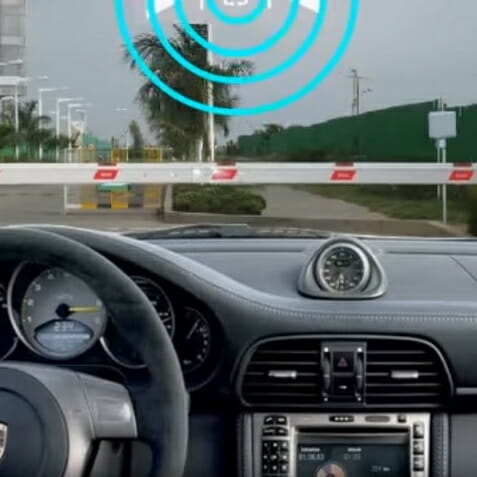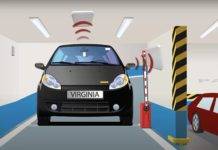Prices / Buy Systems Write A Request
Software Download Free Online Estimate
Parking lot entry and exit control systems are automated systems that are designed to manage the entry and exit of vehicles in parking lots. These systems typically consist of a variety of components such as ticket dispensers, entry and exit barriers, payment stations, and software that controls the overall operation of the system.
Typical Parking Control Systems
When a vehicle enters the parking lot, the driver is typically required to take a ticket from a dispenser at the entry gate. This ticket contains a unique identifier that is used to track the duration of the vehicle’s stay in the parking lot. When the driver leaves the parking lot, they must present their ticket at a payment station and pay the appropriate fee. Once the fee is paid, the exit barrier is raised, allowing the vehicle to leave the parking lot.
More advanced parking lot control systems may also include features such as license plate recognition, pre-paid parking options, and integration with mobile apps that allow drivers to reserve parking spaces in advance or pay for parking from their mobile devices.
Overall, parking lot entry and exit control systems are designed to help parking lot owners manage traffic flow, ensure proper payment for parking, and provide a convenient and secure parking experience for drivers.
Our Parking Lot Entry and Exit Control Systems seamlessly integrate with the I-PASS network and work smoothly in any state where E-ZPass is accepted. This allows users to continue using their existing I-PASS or E-ZPass RFID tags without needing extra tags or modifications. For more information, follow the link about parking systems.
We provide Lifetime Software License.
No Subscriptions, No Monthly Fees!
Parking Lot Control Systems And Main Benefits
RFID (Radio Frequency Identification) technology has become increasingly popular in parking lot entry and exit control systems due to its ability to accurately and quickly identify vehicles using an RFID tag or sticker. UHF (Ultra High Frequency) RFID technology, in particular, has several benefits for parking lot management:
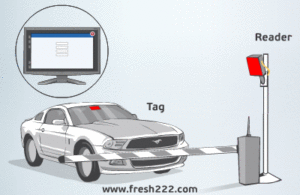
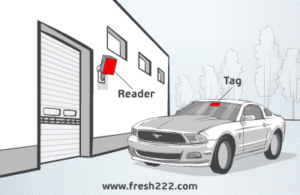
- Improved Efficiency: UHF RFID technology enables faster and more accurate identification of vehicles, reducing wait times at entry and exit points. This can improve the overall efficiency of the parking lot and reduce congestion.
- Increased Security: RFID tags can be programmed with unique identification codes that are difficult to replicate, making it harder for unauthorized vehicles to enter the parking lot. UHF technology allows for longer read ranges, making it easier to identify vehicles from a distance.
- Lower Costs: RFID technology reduces the need for manual ticketing and attendant staff, which can lead to cost savings for parking lot operators. Additionally, UHF RFID tags are durable and can be reused multiple times, reducing the need for frequent replacements.
- Improved Customer Experience: UHF RFID technology provides a seamless experience for customers entering and exiting the parking lot, without the need to roll down their windows or interact with a parking attendant. This can lead to a more positive customer experience and increased customer satisfaction.
Thus RFID UHF technology can provide several benefits for parking lot entry and exit control systems, including improved efficiency, increased security, lower costs, and improved customer experience.
We provide Lifetime Software License.
No Subscriptions, No Monthly Fees!
How RFID Parking Lot Entry And Exit Control System Works
A typical RFID UHF* parking lot entry and exit control system consists of the following components:
- RFID UHF Readers: These are installed at the entry and exit points of the parking lot and are responsible for reading the RFID tags/stickers** attached to vehicles.
- RFID UHF Antennas: These are attached to the readers and are responsible for transmitting and receiving the RFID signals.
- RFID UHF Tags/Stickers: These are attached to the windshield or other visible locations of the vehicle and contain a unique identification code that is used to identify the vehicle.
- Parking Management Software: This software is used to manage the parking lot, track vehicle entry and exit times, and generate reports.

Here’s how the system works:
- Vehicle Entry: When a vehicle enters the parking lot, the RFID reader at the entry point detects the RFID tag/sticker on the vehicle and reads its unique identification code.
- Verification: The identification code is then verified against the parking management software to ensure that the vehicle is authorized to enter the parking lot. If the vehicle is authorized, the entry gate opens automatically
- Parking: The vehicle parks in a designated spot, and the RFID tag/sticker is not needed again until the vehicle exits the parking lot.
- Vehicle Exit: When the vehicle is ready to leave the parking lot, it approaches the exit gate. The RFID reader at the exit point detects the RFID tag/sticker on the vehicle and reads its unique identification code.
- Payment and Verification: The identification code is then verified against the parking management software, and if the vehicle has paid the parking fee or has permission to exit, the exit gate opens automatically. If not, the system can prompt the driver to make a payment or contact an attendant for assistance.
Overall, the RFID UHF parking lot entry and exit control system provides a seamless and efficient parking experience for customers while enabling parking lot operators to track vehicle entry and exit times and improve overall security.
*Ultra High Frequency: 860-940 MHz.
**Parking access control tags, watch the VIDEO
We provide Lifetime Software License. No Subscriptions, No Monthly Fees!
Parking Management Software Free Download
The combination of encrypted data transmission, unique identification information, anti-collision technology, centralized parking lot entry and exit control system, and integration with other security systems makes the parking lot entry and exit control system based on RFID UHF technology a highly secure solution for regulating access to parking lots.
Use of Long-Range Distance Technologies in Parking Lot Entry And Exit Control Systems
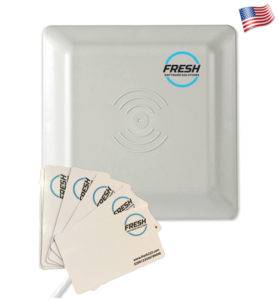
Parking access control systems manufactured by FRESH USA have been tested for many years of use around the world and work perfectly in all weather conditions. Systems developed by Fresh USA uses only contactless technologies such as Wi-Fi, 4G / LTE and RFID UHF long range distance with a frequency of 860MHz – 960MHz. You can integrate the parking management software with other third-party software or your ERP system using a SQL database or deploy a Web-service.
You would be surprised to know the parking lot entry and exit control system has no essential of any controller as each peruser going with worked in memory for a vast names number. Since the initiation of the RFID parking system, it has transformed into an astounding response for parking spaces, garages, strip malls, school grounds. There are without hand and motorized RFID parking lot entry and exit control system which are adequate for garages, grounds, networks that are gated, parking parts and another zone where vehicle control locale is required.
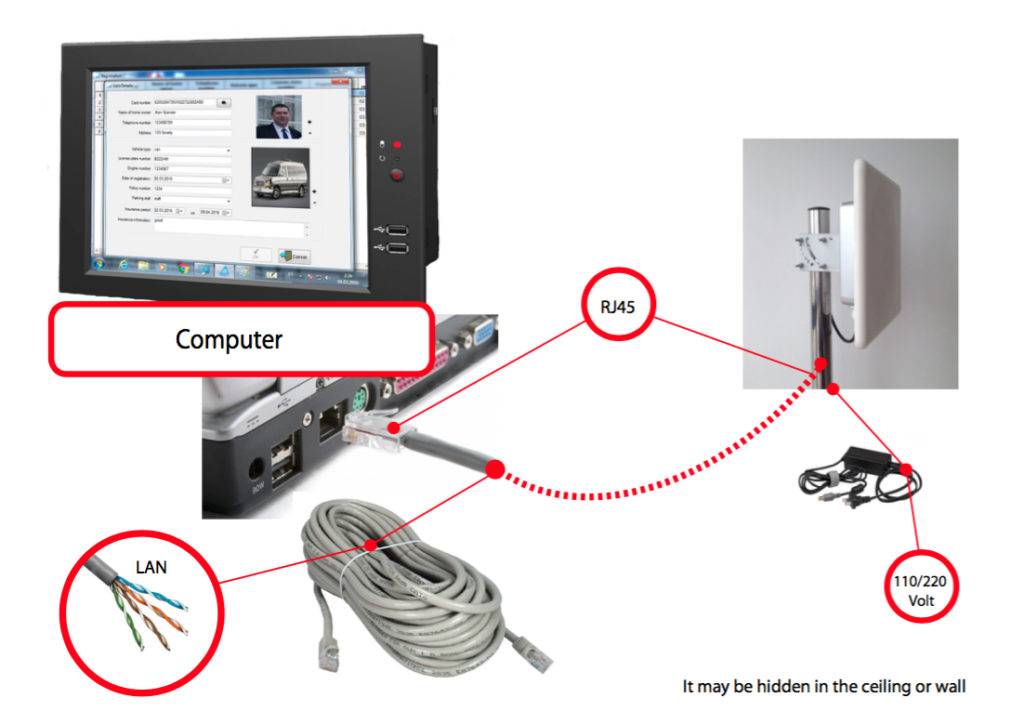
Chicago, Parking Lot Entry And Exit Control Systems
Parking Lot Entry And Exit Control Systems
Introduction
When was the last time you drove into a parking lot and felt that twinge of frustration? Maybe you circled multiple floors, waited in a long line at the exit, or fumbled around for a ticket. Parking might not be the first thing we think of when discussing daily hassles, yet it impacts both our personal schedules and a business’s bottom line. With urbanization growing rapidly, the demand for efficient parking management is rising in tandem.
Context and Importance
Parking lot entry and exit control systems serve a vital role in today’s transportation ecosystem. They prevent chaos, maximize available space, and ensure drivers can enter or exit quickly and securely. Whether it’s a small residential complex or a sprawling commercial garage, a well-implemented system can dramatically boost user satisfaction—and slash overhead costs.
Purpose of the Article
We’re here to unpack the nitty-gritty of parking lot control systems: what they are, how they function, and why you should care. We’ll take a deep dive into technologies shaping the industry, design considerations, real-life use cases, and best practices to help you make informed decisions—without the industry jargon.
We provide Lifetime Software License. No Subscriptions, No Monthly Fees!
Parking Management Software Free Download
Understanding Parking Lot Entry and Exit Control Systems
Definition
Parking lot entry and exit control systems refer to the blend of hardware (like gates, ticket dispensers, card readers) and software (like management dashboards, payment processing platforms) orchestrated to regulate vehicle flow. These systems grant or deny access to drivers, track usage data, and handle everything from payment processing to security checks.
Core Functions
-
- Vehicle Authorization: Ensuring only authorized individuals can enter.
- Efficient Flow: Minimizing backups and congestion.
- Data Collection: Gathering usage analytics, which help operators optimize space and revenue.
Key Components of Parking Access Control
Gates, Barriers, and Bollards
Think of these as the physical “checkpoints.” A gate or barrier that automatically lifts after validating a driver’s credentials is the hallmark of modern parking control. In some setups, bollards—vertical posts that can retract—replace or supplement gates for added security.
Ticketing and Credentialing
- Paper Tickets: Classic but increasingly phased out. They can still be found in smaller or older facilities.
- RFID/Proximity Cards: More popular in corporate and residential settings for frictionless, contactless operations.
- License Plate Recognition (LPR): Eliminates the need for any physical ticket by scanning vehicle plates.
Software and User Interfaces
Operators typically rely on a digital dashboard to monitor vehicles in real time, manage payments, and receive alerts. For drivers, user-facing interfaces—like kiosks or mobile apps—guide them through entry, payment, and exit seamlessly.
Types of Parking Lot Control Systems
Manual Systems
These rely heavily on human oversight. You might see a parking attendant handing out paper tickets at entry or manually operating a gate. While it’s the simplest approach, it lacks scalability and can be error-prone.
Semi-Automated Systems
Semi-automated setups combine limited human intervention with technological aids like basic ticket dispensers or card readers. They’re a middle ground for smaller facilities seeking efficiency without the upfront cost of a fully automated solution.
Fully Automated Systems
The gold standard for large-scale or high-traffic environments. Automated systems use LPR cameras, RFID readers, and sophisticated software to handle most tasks. They’re typically more expensive to install but slash long-term labor costs and greatly improve throughput.
Technologies Driving Modern Parking Solutions
RFID and Contactless Cards
Radio-Frequency Identification (RFID) has emerged as a dependable solution, allowing vehicles fitted with tags or cards to be recognized instantly at the gate. The system triggers a barrier to open without requiring the driver to fumble with paper tickets or cash.
License Plate Recognition (LPR)
High-resolution cameras capture license plate details, matching them against a stored database. Perfect for subscription-based parking, visitor management, or even toll roads, LPR is valued for its speed, convenience, and reduced environmental impact (no printed tickets needed).
Biometric Integrations
Fingerprint or facial recognition is more common in access control for buildings but is slowly making its way into parking systems. Especially relevant in high-security facilities or corporate campuses, biometrics ensure that only the rightful owner gains entry.
Mobile and App-Based Access
Think of using your smartphone to find a spot, reserve it, and even pay for it in a single tap. Mobile apps can also direct drivers to free spaces, collect payments, and send receipts—adding a level of convenience that’s especially appealing in busy urban centers.
Design Considerations for Efficient Traffic Flow
Entrance and Exit Layout
A well-planned design can prevent vehicles from bottlenecking during peak hours. Separate lanes for entry and exit, additional queuing space, and clear signage reduce confusion while speeding up the process.
Lane Configuration
Some lots deploy multiple entry lanes—such as dedicated lanes for monthly pass holders or staff. This segmentation prevents cross-traffic jams and ensures each user group has a streamlined approach.
Signage and Wayfinding
Have you ever felt lost in a parking garage with arrows that lead you in circles? Proper signage—visible from a distance and logically placed—makes or breaks the user experience. Integrating digital signboards or LED displays that show available spaces can cut search time dramatically.
Security and Safety Features
Preventing Unauthorized Access
From mechanical barriers to advanced encryption (used in RFID systems), the core mission is to keep unapproved vehicles out. Additional layers of security might include user access logs or integrated alarm systems that trigger if someone forces entry.
Surveillance and Alarm Systems
CCTV cameras and motion detectors keep a 24/7 watch on the premises. Modern setups use smart analytics to detect suspicious activities—like a tailgating vehicle trying to sneak in behind another.
Data Encryption and Protection
With digital credentials and personal information in play, robust encryption is crucial. As parking systems become internet-connected, they also become potential targets for cyber threats. Many solutions incorporate advanced data protection protocols—some even using Identification Friend or Foe (IFF) technology to encrypt radio signals.
Economic Benefits and Revenue Models
Ticket-Based Revenue
In a traditional format, drivers pull a ticket upon entry and pay at an exit station. Although easy to understand, this method can slow down peak-hour traffic and requires ongoing ticket production costs.
Online Payments and Subscriptions
Recurring billing for monthly parkers, digital wallets for daily visitors, and even pay-per-use models are all standard in modern systems. Mobile apps and online portals allow for quick, contactless payments.
Dynamic Pricing Strategies
Why charge a flat rate all day if demand spikes at certain times? Dynamic pricing adjusts fees based on real-time occupancy. This encourages off-peak usage and maximizes revenue by charging premium rates when spaces are scarce.
Environmental and Sustainability Aspects
Reducing Idling Time
Fewer lines at the entrance and exit mean less time spent idling, lowering carbon emissions. Some systems even direct drivers to open spots or highlight the least congested exit route, further cutting wasted time.
EV Charging Integration
As electric vehicles proliferate, an increasing number of parking systems incorporate EV charging stations. Such additions make it convenient for eco-conscious drivers—potentially attracting more visitors while supporting sustainability goals.
Smart Lighting and Energy Efficiency
Motion-activated LED lights or solar-powered fixtures not only reduce utility bills but also create a safer environment. Some advanced systems automatically dim lights in vacant areas, cutting costs without compromising security.
Challenges in Implementation
Financial and Infrastructure Barriers
Upfront costs can be high—especially for fully automated or cutting-edge solutions. Retrofits might require structural changes, rewiring, or hardware replacements. However, the long-term gains typically offset these expenses.
Technical Complexity
Integrating new hardware (RFID antennas, LPR cameras) with existing software can be tricky. Also, advanced features like mobile payments and real-time notifications need stable internet connectivity and robust data management.
User Adoption and Training
A well-designed system is pointless if drivers don’t know how to use it. Parking attendants and security staff also need training on troubleshooting, especially in stand-alone systems that function autonomously.
Case Studies
Commercial Parking Garages
A busy downtown garage might see thousands of vehicles daily. By adopting automated gates, LPR, and integrated payment apps, the facility significantly reduces manual labor and traffic backups. Over time, real-time data analysis helps them optimize rates—peak times are priced higher while off-peak hours are discounted to encourage usage.
Residential Complexes
Condominiums and gated communities typically rely on RFID tags or key fobs for residents, while visitors receive short-term credentials. This arrangement fosters a sense of exclusivity and security, keeping random vehicles from clogging private spaces.
Healthcare and Educational Campuses
Large hospitals and university campuses often blend multiple access methods—like staff ID badges and visitor tickets. In addition to controlling entry, these systems provide real-time occupancy updates. Staff can quickly find open parking in an emergency, while visitors get easy directions to specific lots or buildings.
Future Trends in Parking Lot Entry and Exit Control
AI and Machine Learning Applications
Picture a parking system that forecasts demand, automatically adjusts pricing, and even directs you to the ideal space. With machine learning analyzing daily usage patterns, the system becomes more predictive and user-friendly over time.
IoT-Enabled Solutions
The Internet of Things (IoT) plays nicely with parking management. Sensors can report available spots in real time, transmit data to a centralized dashboard, and even send push notifications to a driver’s phone. This interconnectedness improves traffic flow and provides operators with a goldmine of analytical data.
Autonomous Vehicles and V2X
As self-driving cars edge into the mainstream, parking will transform further. Vehicles might “drop off” passengers at building entrances, then proceed to a designated area to park themselves. Vehicle-to-everything (V2X) communications will link cars with infrastructure, letting them coordinate entry, exit, and even payments autonomously.
Integration with Other Systems
Building Management Systems (BMS)
In large commercial or mixed-use developments, parking integration with BMS ensures that everything—lighting, HVAC, security cameras—operates harmoniously. For instance, the system can adjust lighting in parking areas based on occupancy data gleaned from gates.
Smart City Framework
Cities worldwide are adopting big data solutions to tackle congestion. Parking data can feed into city-wide traffic management platforms, helping officials monitor overall vehicle movements and plan expansions or re-routing.
Security and Access Control Ecosystems
Advanced parking systems can share data with card-based door access control or visitor management software. This synergy offers a holistic security viewpoint, enabling property managers to track someone from the parking lot to the building entrance and beyond.
Selecting the Right System for Your Needs
Assessing Facility Size and Traffic Volume
The bigger the facility and heavier the traffic, the more robust the solution needed. A small office lot might do fine with semi-automated gates, whereas a high-traffic airport requires multiple LPR-equipped entry lanes.
Budget and Scalability
Forecast future growth before making an investment. While fully automated solutions carry higher initial costs, they’re often simpler to expand if your user base skyrockets.
Vendor Evaluation
Look for vendors with proven track records, robust customer support, and flexible solutions that integrate with your existing infrastructure. Also, confirm whether they offer ongoing software updates and hardware warranties.
Maintenance and Upkeep
Routine Inspections and Servicing
Regularly check gates, card readers, and cameras for wear and tear. Even simple issues like misaligned barriers or dust on LPR cameras can disrupt operation.
Software Updates and Firmware
As new security threats emerge, or as your system’s feature set grows, you’ll need the latest software patches. Ensure your vendor provides timely updates or that your in-house IT staff can manage them.
Training and Support
Consistent training ensures staff can handle day-to-day troubleshooting. Quick, knowledgeable support from your vendor can minimize downtime and keep user satisfaction high.
Conclusion
Parking lot entry and exit control systems aren’t just about gates and tickets—they’re a gateway (pun intended) to a smoother, more secure, and more profitable parking environment. From the simplest manual setups to advanced, AI-driven solutions, these systems have come a long way. By carefully assessing your facility’s needs, embracing the right technology, and planning for future growth, you can create a parking experience that benefits drivers and owners alike. Whether you manage a small residential complex or a massive corporate garage, the same basic principle applies: streamlined, safe, and user-friendly parking fosters goodwill, efficiency, and economic value.
We provide Lifetime Software License. No Subscriptions, No Monthly Fees!
Parking Management Software Free Download
FAQs
1. How do ticketless systems work?
Ticketless solutions often rely on license plate recognition or RFID tags. When a vehicle approaches, the system records its plate number or reads the tag ID. Payment can then be processed automatically, eliminating paper tickets.
2. What are the key benefits of an automated parking solution?
Automated solutions reduce manual labor, accelerate vehicle throughput, and often deliver real-time data insights. They also tend to improve security by minimizing human error and providing digital logs for audits.
3. Can these systems integrate with existing security setups?
Absolutely. Most modern parking control platforms offer APIs or standardized communication protocols (like Wiegand or TCP/IP) to interface with surveillance cameras, door access controls, or building management systems.
4. Are biometric systems worth the investment?
It depends on your security level and budget. Biometric methods offer robust identification but can be pricier and require more maintenance. They’re popular in high-security or corporate settings where controlling who enters is paramount.
5. How does dynamic pricing impact users?
Dynamic pricing can initially surprise some drivers, but it often results in better space availability during peak times. Facilities can also use discounts to encourage parking at off-peak hours, balancing loads and improving customer satisfaction.

